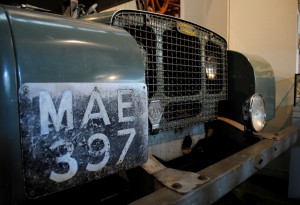Written by Adam Koszary, Project Officer for ‘Our Country Lives’.
The Museum of English Rural Life is transforming, and our vision for the new direction and focus of the museum is reflected in our project title: ‘Our Country Lives’. I have been employed specifically to work on this project, and to help find a way of retaining what is best about MERL as it is, whilst also exploring the vast potential of its collections. Our objects are not only great in telling the story of agricultural technology and crafts, but also how the livelihoods and communities of our countryside have shifted and changed, reflecting changing economic and technological conditions.
One perfect example, already introduced below by Kate, is the Series 1 Land Rover – known as ‘MAE’, from its number plate MAE397. It is immediately recognisable as a symbol of the countryside – it almost seems mandatory to be wearing a flat-cap while driving one – yet it is also a symbol of the great shift in the way of rural life in the mid-late 20th century.
I was put in mind of MAE on my commute into Reading this morning, as an article in the Metro informed me that the Series 1 is celebrating its 65th Anniversary this year. While the article notes that the Land Rover was created for farmers, and was sold on its ability to traverse all terrain, it acknowledged that most Land Rovers are now used as status symbols and are more likely to be used for picking up the kids from school than driving through fords. However, it is this new appeal and the marketing of the rural way of life (i.e. as a more refined and quintessentially ‘English’ identity) that has no doubt saved its Solihull factory from closure, unlike the infamous case of Rover’s nearby Longbridge factory.
It is these kind of threads, which track how rural life has shifted and changed, often driven by economic factors, which will be more fully explored in ‘Our Country Lives’. The Land Rover itself is also a part of our new initiative of collecting objects relating to ‘20th Century Rural Cultures’, and it is essential that each of our objects reflects a person or story which encapsulates in some way how rural life has changed, or in some cases persevered, through this past century of rapid change. For this project to succeed, we at the Museum of English Rural Life will be needing all the help we can get from our visitors and rural communities, so please keep an eye out for opportunities in helping with this exciting new redevelopment!


